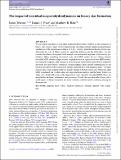Files in this item
The impact of non-ideal magnetohydrodynamics on binary star formation
Item metadata
| dc.contributor.author | Wurster, J. | |
| dc.contributor.author | Price, D. J. | |
| dc.contributor.author | Bate, M. R. | |
| dc.date.accessioned | 2019-10-22T12:30:05Z | |
| dc.date.available | 2019-10-22T12:30:05Z | |
| dc.date.issued | 2017-04 | |
| dc.identifier | 262150395 | |
| dc.identifier | e437b621-a368-4668-8446-3b2a879de749 | |
| dc.identifier | 85023767578 | |
| dc.identifier.citation | Wurster , J , Price , D J & Bate , M R 2017 , ' The impact of non-ideal magnetohydrodynamics on binary star formation ' , Monthly Notices of the Royal Astronomical Society , vol. 466 , no. 2 , pp. 1788-1804 . https://doi.org/10.1093/mnras/stw3181 | en |
| dc.identifier.issn | 0035-8711 | |
| dc.identifier.other | Bibtex: WursterPriceBate2017 | |
| dc.identifier.other | ORCID: /0000-0003-0688-5332/work/63716935 | |
| dc.identifier.uri | https://hdl.handle.net/10023/18743 | |
| dc.description.abstract | We investigate the effect of non-ideal magnetohydrodynamics (MHD) on the formation of binary stars using a suite of three-dimensional smoothed particle magnetohydrodynamics simulations of the gravitational collapse of 1 M⊙, rotating, perturbed molecular-cloud cores. Alongside the role of Ohmic resistivity, ambipolar diffusion and the Hall effect, we also examine the effects of magnetic field strength, orientation and amplitude of the density perturbation. When modelling sub-critical cores, ideal MHD models do not collapse whereas non-ideal MHD models collapse to form single protostars. In supercritical ideal MHD models, increasing the magnetic field strength or decreasing the initial-density perturbation amplitude decreases the initial binary separation. Strong magnetic fields initially perpendicular to the rotation axis suppress the formation of binaries and yield discs with magnetic fields ∼10 times stronger than if the magnetic field was initially aligned with the rotation axis. When non-ideal MHD is included, the resulting discs are larger and more massive, and the binary forms on a wider orbit. Small differences in the supercritical cores caused by non-ideal MHD effects are amplified by the binary interaction near periastron. Overall, the non-ideal effects have only a small impact on binary formation and early evolution, with the initial conditions playing the dominant role. | |
| dc.format.extent | 17 | |
| dc.format.extent | 9655578 | |
| dc.language.iso | eng | |
| dc.relation.ispartof | Monthly Notices of the Royal Astronomical Society | en |
| dc.subject | Magnetic fields | en |
| dc.subject | MHD | en |
| dc.subject | Methods: numerical | en |
| dc.subject | Binaries: general | en |
| dc.subject | Stars: formation | en |
| dc.subject | QA75 Electronic computers. Computer science | en |
| dc.subject | QB Astronomy | en |
| dc.subject | QC Physics | en |
| dc.subject | NDAS | en |
| dc.subject.lcc | QA75 | en |
| dc.subject.lcc | QB | en |
| dc.subject.lcc | QC | en |
| dc.title | The impact of non-ideal magnetohydrodynamics on binary star formation | en |
| dc.type | Journal article | en |
| dc.contributor.institution | University of St Andrews. School of Physics and Astronomy | en |
| dc.identifier.doi | https://doi.org/10.1093/mnras/stw3181 | |
| dc.description.status | Peer reviewed | en |
| dc.identifier.url | https://arxiv.org/abs/1612.02016 | en |
This item appears in the following Collection(s)
Items in the St Andrews Research Repository are protected by copyright, with all rights reserved, unless otherwise indicated.

